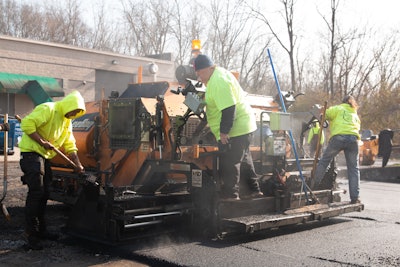
It can be difficult for contractors to engage with clients who want an effective solution but can’t afford the associated cost. When the two parties disagree on budget, it seems like there are only two solutions: either the contractor will lose money on the project or the customer will be unhappy at the end of the project.
After more than 20 years in the industry, I’ve seen my fair share of these situations. Sometimes it’s a large, commercial project with complex challenges and other times it’s a small business that just needs their lot surface touched up – everyone has a budget they’re working around. While these budgeting challenges can seem impossible and far too frequent, it is possible to figure out a middle ground and avoid losing money or ending up with an unhappy client. Over the years, I’ve learned some key ways to handle misaligned budgets and create a third option.
As it often happens with learning opportunities, I learned the most from a job that had the potential to be disastrous for my company and our client.
An Example We Learned From
Recently, we bid for a big project in our area after reviewing the scope of work. We didn’t know the client’s budget, but the company owned a large industrial manufacturing site and wanted the whole lot completely replaced. Based on our experience, we estimated the project would cost around $1 million.
We ended up winning the project, but the budget wasn’t quite what we were expecting. Their maximum available spend was only 70% of our anticipated budget. We couldn’t approach the job the way we had planned to, so we had to think strategically and get to work redesigning our original plan, trying to make up for the $300,000 gap we now faced.
Instead of removing the parking lot and replacing it, as we had originally proposed, we decided we could take a different approach. What we initially viewed as a complete reconstruction became more of a maintenance project.
The base of the parking lot was still in good shape – just the surface was deteriorated – so instead of milling it all down to stone and replacing it like we had originally proposed, we decided to adjust the grade of the lot and do profile milling. We focused on milling around the areas that we had to match up to existing grades – such as concrete pads and trucking docks – to make the entire surface flat. By removing just the surface to add extra strength, we kept the sub-lot intact.
We then were able to overlay and use less asphalt on the paving area. Because we were working around a dock, we made the surface thinner the further we got from it and once we got out so far, we were able to pave over the top of the existing surface. The profile milling also gave us the material we needed to make the surface thicker and heavy-duty – without the elevated cost of adding more asphalt – which was important for the truck traffic that would be commonplace at this industrial manufacturing site.
This change in procedure saved the client roughly $400,000 without impacting the quality of the work or the time needed to complete the project. The whole process took six weeks, and, importantly, we worked around the company’s schedule so they were able to continue working during the project. This saved even more money because the client did not incur any extra costs for downtime.
6 Ways to Approach Budget Issues
We learned a lot from this project and the many other challenging projects we’ve faced as a company. Here are a few of the pieces of advice I’d give to someone struggling with a budget issue:
- Don’t underestimate the power of maintaining versus creating new.
It’s easy for clients and paving professionals alike to want to go in and wipe something out to replace it with something fresh and new. There’s nothing more satisfying than a nice set of before-and-after pictures that show just how needed a complete overhaul was. But just because the client thinks they need to completely replace something, or because that’s how you planned to approach a project, doesn’t mean that’s the best route to take. It’s often far from the most affordable option as well. By considering maintenance options that save time and money, you will open your company up to more varieties of projects and a lot more business.
- Figure out the client’s priority and adjust accordingly.
No two clients are going to have the exact same needs, preferences, and priorities. Make it a priority to figure out early on what each client’s priorities are so that you can always be adapting towards them. If a client wants a long-lasting fix, focus on that and use their budget accordingly. If their priority is a quick fix so they can get back to work – with a more in-depth replacement down the road – do everything you can to make that happen. While you can learn from each project, every job requires you to rethink strategy and come up with personalized solutions that fit the client and the budget.
- Effectively communicate restrictions caused by budget.
Something important to remember is that your clients are not in the paving industry and likely won’t understand the intricacies of paving work. From the estimating process all the way to the completion of the project, it’s vital that you communicate clearly with them. By explaining what you’re doing, why you’re doing it, and why it’s the best option for the price, you will help manage client expectations and increase the chances of having a happy customer when you’re done.
- Provide multiple options.
If you give your clients one option and they don’t like it, they won’t choose to work with you. If possible, spend the time to provide a few different options. Allowing people to choose among a cheap, moderate, and more-expensive option will demonstrate what you can do with varying resources and also show them you realize that budget is important. Having them buy in to a certain strategy and budget at the beginning will also help manage their expectations throughout the project.
- Think through how the space is ideally going to function.
This thought process will likely occur as you think through your client’s priorities and come up with multiple options, but it’s important to regularly remind yourself how your work will end up functioning for your client. If the lot is going to be used by heavy-duty trucks and semis, your approach should be different than a rarely-used driveway. Keeping this in mind throughout the project can help you come up with unique ways to solve problems and go the extra mile for clients, and it will also impact how you decide to use the budget.
- Save money in unexpected places.
Ask yourself if there are any opportunities to save your client money without sacrificing quality of work. A great example of this is if a client doesn’t have to shut down their business while you do your job, he or she can improve their facilities without taking a big hit and losing days or weeks of work. To achieve this for our client, we worked in smaller increments than usual and worked with the property tenants to create a phasing schedule that redirected drivers to different docks when certain areas were shut down. This would not have been possible if we had gone in, removed the entire lot, and then had to replace it, so it further emphasized why maintenance was a better option in this case.
Also consider how doing the project at different points in the year could save money. Often we are busiest in the fall when everyone tries to fit in projects before the winter and so our rates might be higher then. We did this project in the spring, which was a great opportunity for us to have steady work and it saved our client money.
While budgeting differences can be difficult to work around, they are not impossible to deal with. Working around our client’s schedule and switching our thinking about what the project required to be successful saved our client a lot of money and created a strong client relationship. By thinking strategically, planning ahead, considering alternatives, and communicating with clients, you can create effective solutions with smaller budgets.
Bob Lester is president and CEO of Dura-Seal, a sealcoating, asphalt, and concrete services company based in Columbus, OH. He has worked in the paving industry for over 20 years, leading two buyouts, an acquisition, and the sale of an equipment manufacturing company at Dura-Seal. Prior to joining the company, Bob studied business finance at Otterbein University.











![Lee Boy Facility 2025 17 Use[16]](https://img.forconstructionpros.com/mindful/acbm/workspaces/default/uploads/2025/09/leeboy-facility-2025-17-use16.AbONDzEzbV.jpg?ar=16%3A9&auto=format%2Ccompress&fit=crop&h=135&q=70&w=240)








